Appraisal of Qualitative Study: Patient Safety in Home Hospice Care
VerifiedAdded on 2020/05/16
|5
|1077
|75
Report
AI Summary
This report is an appraisal of a qualitative study that investigated patient safety events in home hospice care, focusing on the experiences of interdisciplinary team members. The study, published in the Journal of Palliative Medicine, employed semi-structured interviews in two phases to gather data from hospice staff and leaders, aiming to understand the nature and contributing factors of patient safety incidents. The appraisal evaluates the study's methods, including sampling, data collection, and analysis, assessing their appropriateness and effectiveness in obtaining in-depth data and avoiding biases. The findings, which identify common forms of patient harm such as falls and symptom mismanagement, are examined for their credibility and clinical significance. The report highlights the study's strengths in providing new perspectives and insights into patient safety in home hospice care, as well as its potential to inform future research and improve patient care.
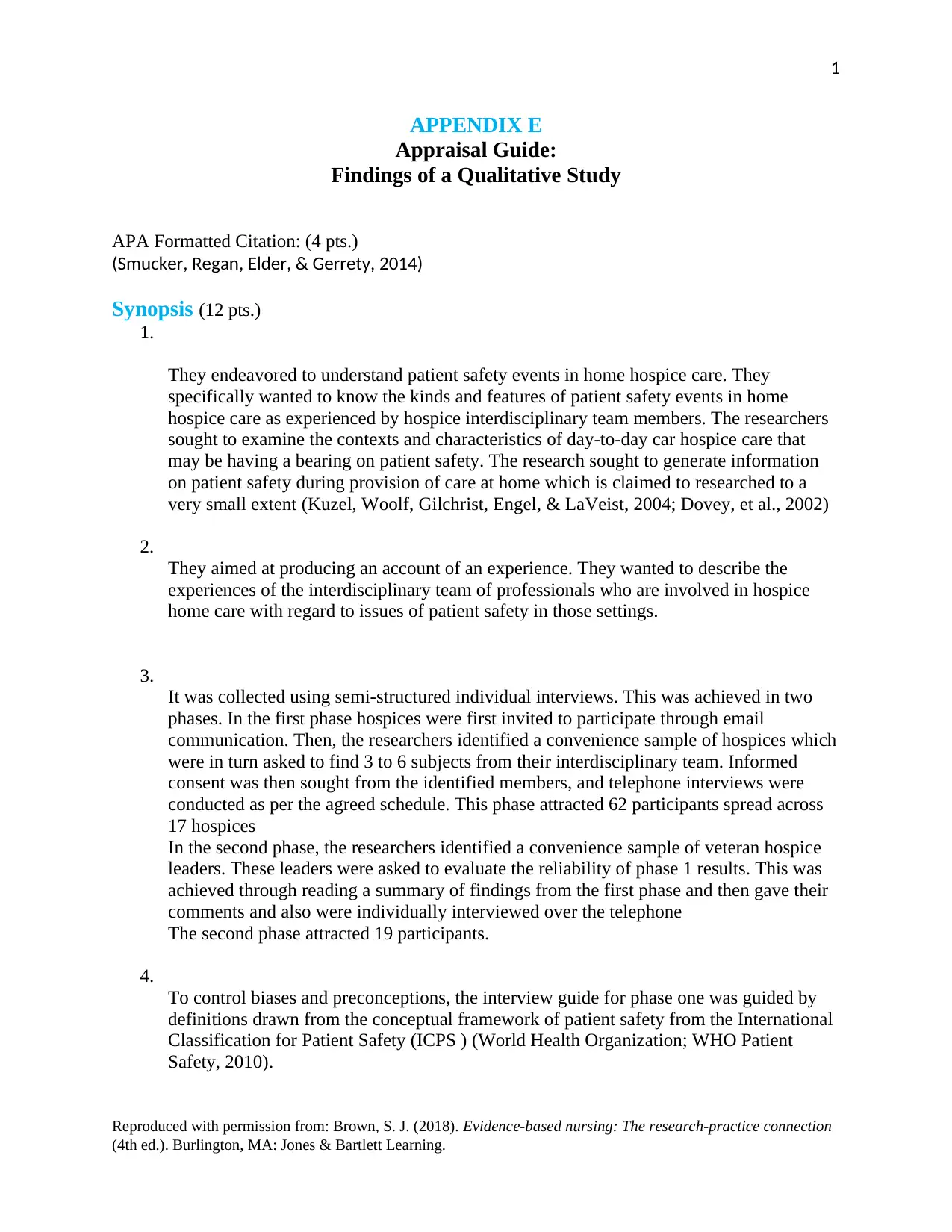
APPENDIX E
Appraisal Guide:
Findings of a Qualitative Study
APA Formatted Citation: (4 pts.)
(Smucker, Regan, Elder, & Gerrety, 2014)
Synopsis (12 pts.)
1.
They endeavored to understand patient safety events in home hospice care. They
specifically wanted to know the kinds and features of patient safety events in home
hospice care as experienced by hospice interdisciplinary team members. The researchers
sought to examine the contexts and characteristics of day-to-day car hospice care that
may be having a bearing on patient safety. The research sought to generate information
on patient safety during provision of care at home which is claimed to researched to a
very small extent (Kuzel, Woolf, Gilchrist, Engel, & LaVeist, 2004; Dovey, et al., 2002)
2.
They aimed at producing an account of an experience. They wanted to describe the
experiences of the interdisciplinary team of professionals who are involved in hospice
home care with regard to issues of patient safety in those settings.
3.
It was collected using semi-structured individual interviews. This was achieved in two
phases. In the first phase hospices were first invited to participate through email
communication. Then, the researchers identified a convenience sample of hospices which
were in turn asked to find 3 to 6 subjects from their interdisciplinary team. Informed
consent was then sought from the identified members, and telephone interviews were
conducted as per the agreed schedule. This phase attracted 62 participants spread across
17 hospices
In the second phase, the researchers identified a convenience sample of veteran hospice
leaders. These leaders were asked to evaluate the reliability of phase 1 results. This was
achieved through reading a summary of findings from the first phase and then gave their
comments and also were individually interviewed over the telephone
The second phase attracted 19 participants.
4.
To control biases and preconceptions, the interview guide for phase one was guided by
definitions drawn from the conceptual framework of patient safety from the International
Classification for Patient Safety (ICPS ) (World Health Organization; WHO Patient
Safety, 2010).
Reproduced with permission from: Brown, S. J. (2018). Evidence-based nursing: The research-practice connection
(4th ed.). Burlington, MA: Jones & Bartlett Learning.
1
Appraisal Guide:
Findings of a Qualitative Study
APA Formatted Citation: (4 pts.)
(Smucker, Regan, Elder, & Gerrety, 2014)
Synopsis (12 pts.)
1.
They endeavored to understand patient safety events in home hospice care. They
specifically wanted to know the kinds and features of patient safety events in home
hospice care as experienced by hospice interdisciplinary team members. The researchers
sought to examine the contexts and characteristics of day-to-day car hospice care that
may be having a bearing on patient safety. The research sought to generate information
on patient safety during provision of care at home which is claimed to researched to a
very small extent (Kuzel, Woolf, Gilchrist, Engel, & LaVeist, 2004; Dovey, et al., 2002)
2.
They aimed at producing an account of an experience. They wanted to describe the
experiences of the interdisciplinary team of professionals who are involved in hospice
home care with regard to issues of patient safety in those settings.
3.
It was collected using semi-structured individual interviews. This was achieved in two
phases. In the first phase hospices were first invited to participate through email
communication. Then, the researchers identified a convenience sample of hospices which
were in turn asked to find 3 to 6 subjects from their interdisciplinary team. Informed
consent was then sought from the identified members, and telephone interviews were
conducted as per the agreed schedule. This phase attracted 62 participants spread across
17 hospices
In the second phase, the researchers identified a convenience sample of veteran hospice
leaders. These leaders were asked to evaluate the reliability of phase 1 results. This was
achieved through reading a summary of findings from the first phase and then gave their
comments and also were individually interviewed over the telephone
The second phase attracted 19 participants.
4.
To control biases and preconceptions, the interview guide for phase one was guided by
definitions drawn from the conceptual framework of patient safety from the International
Classification for Patient Safety (ICPS ) (World Health Organization; WHO Patient
Safety, 2010).
Reproduced with permission from: Brown, S. J. (2018). Evidence-based nursing: The research-practice connection
(4th ed.). Burlington, MA: Jones & Bartlett Learning.
1
Paraphrase This Document
Need a fresh take? Get an instant paraphrase of this document with our AI Paraphraser
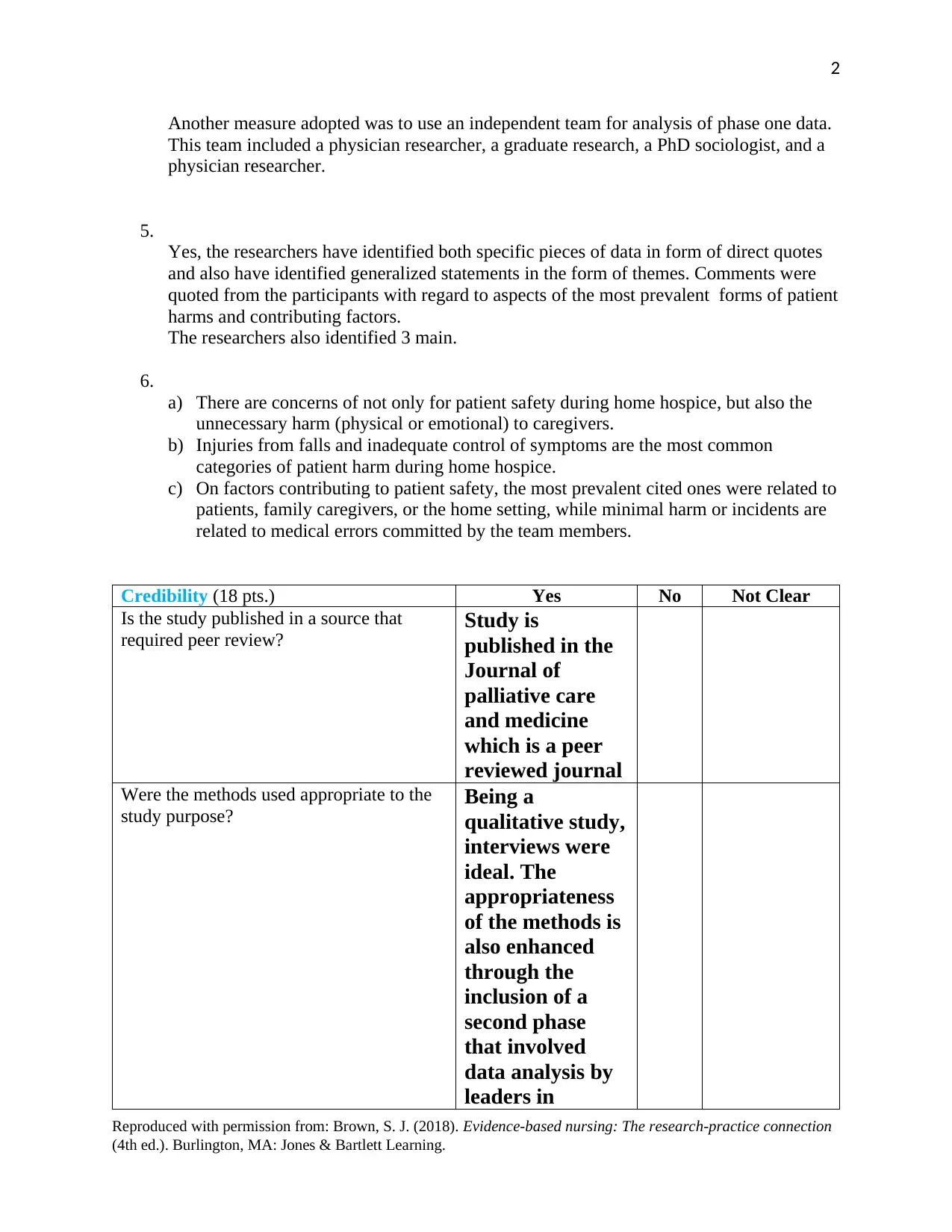
Another measure adopted was to use an independent team for analysis of phase one data.
This team included a physician researcher, a graduate research, a PhD sociologist, and a
physician researcher.
5.
Yes, the researchers have identified both specific pieces of data in form of direct quotes
and also have identified generalized statements in the form of themes. Comments were
quoted from the participants with regard to aspects of the most prevalent forms of patient
harms and contributing factors.
The researchers also identified 3 main.
6.
a) There are concerns of not only for patient safety during home hospice, but also the
unnecessary harm (physical or emotional) to caregivers.
b) Injuries from falls and inadequate control of symptoms are the most common
categories of patient harm during home hospice.
c) On factors contributing to patient safety, the most prevalent cited ones were related to
patients, family caregivers, or the home setting, while minimal harm or incidents are
related to medical errors committed by the team members.
Credibility (18 pts.) Yes No Not Clear
Is the study published in a source that
required peer review? Study is
published in the
Journal of
palliative care
and medicine
which is a peer
reviewed journal
Were the methods used appropriate to the
study purpose? Being a
qualitative study,
interviews were
ideal. The
appropriateness
of the methods is
also enhanced
through the
inclusion of a
second phase
that involved
data analysis by
leaders in
Reproduced with permission from: Brown, S. J. (2018). Evidence-based nursing: The research-practice connection
(4th ed.). Burlington, MA: Jones & Bartlett Learning.
2
This team included a physician researcher, a graduate research, a PhD sociologist, and a
physician researcher.
5.
Yes, the researchers have identified both specific pieces of data in form of direct quotes
and also have identified generalized statements in the form of themes. Comments were
quoted from the participants with regard to aspects of the most prevalent forms of patient
harms and contributing factors.
The researchers also identified 3 main.
6.
a) There are concerns of not only for patient safety during home hospice, but also the
unnecessary harm (physical or emotional) to caregivers.
b) Injuries from falls and inadequate control of symptoms are the most common
categories of patient harm during home hospice.
c) On factors contributing to patient safety, the most prevalent cited ones were related to
patients, family caregivers, or the home setting, while minimal harm or incidents are
related to medical errors committed by the team members.
Credibility (18 pts.) Yes No Not Clear
Is the study published in a source that
required peer review? Study is
published in the
Journal of
palliative care
and medicine
which is a peer
reviewed journal
Were the methods used appropriate to the
study purpose? Being a
qualitative study,
interviews were
ideal. The
appropriateness
of the methods is
also enhanced
through the
inclusion of a
second phase
that involved
data analysis by
leaders in
Reproduced with permission from: Brown, S. J. (2018). Evidence-based nursing: The research-practice connection
(4th ed.). Burlington, MA: Jones & Bartlett Learning.
2
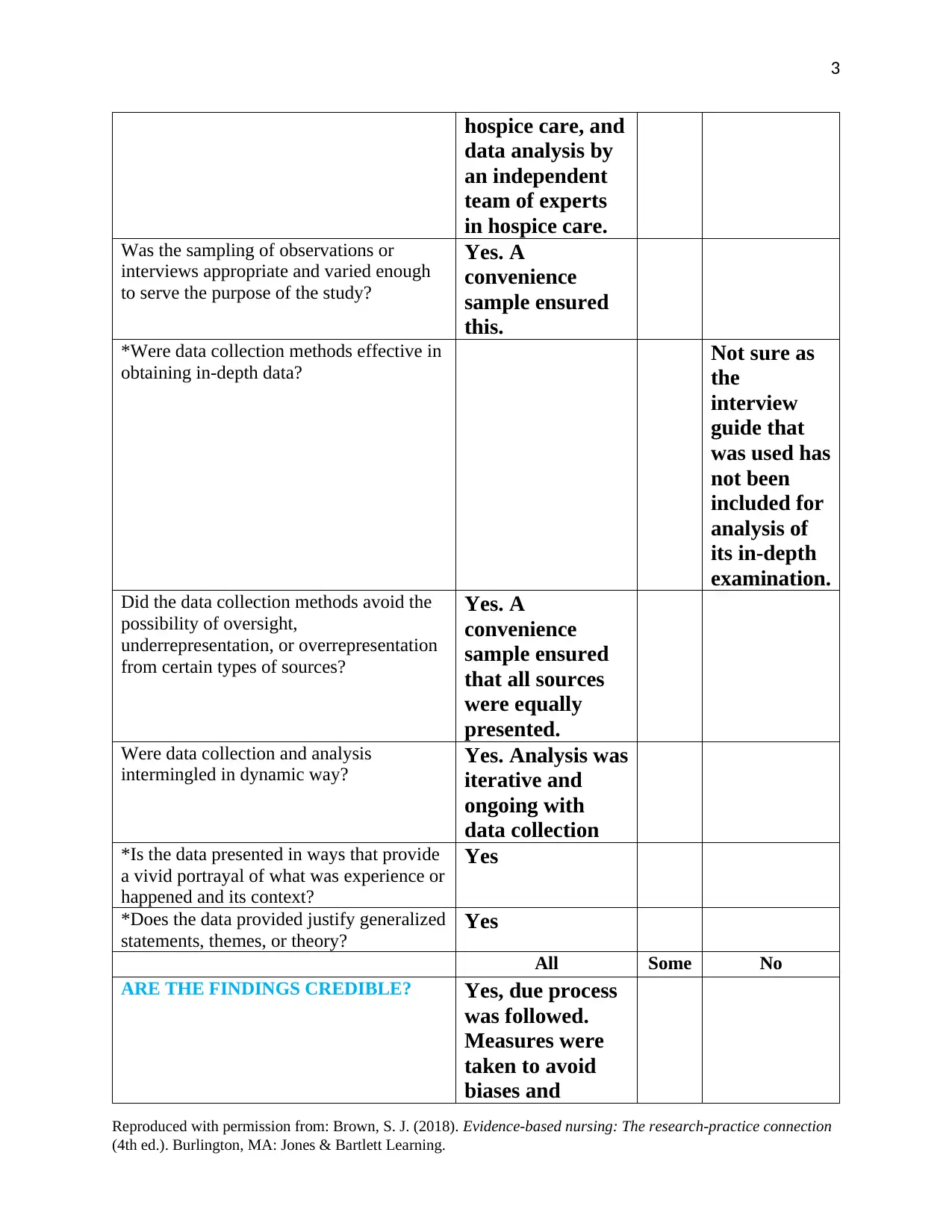
hospice care, and
data analysis by
an independent
team of experts
in hospice care.
Was the sampling of observations or
interviews appropriate and varied enough
to serve the purpose of the study?
Yes. A
convenience
sample ensured
this.
*Were data collection methods effective in
obtaining in-depth data? Not sure as
the
interview
guide that
was used has
not been
included for
analysis of
its in-depth
examination.
Did the data collection methods avoid the
possibility of oversight,
underrepresentation, or overrepresentation
from certain types of sources?
Yes. A
convenience
sample ensured
that all sources
were equally
presented.
Were data collection and analysis
intermingled in dynamic way? Yes. Analysis was
iterative and
ongoing with
data collection
*Is the data presented in ways that provide
a vivid portrayal of what was experience or
happened and its context?
Yes
*Does the data provided justify generalized
statements, themes, or theory? Yes
All Some No
ARE THE FINDINGS CREDIBLE? Yes, due process
was followed.
Measures were
taken to avoid
biases and
Reproduced with permission from: Brown, S. J. (2018). Evidence-based nursing: The research-practice connection
(4th ed.). Burlington, MA: Jones & Bartlett Learning.
3
data analysis by
an independent
team of experts
in hospice care.
Was the sampling of observations or
interviews appropriate and varied enough
to serve the purpose of the study?
Yes. A
convenience
sample ensured
this.
*Were data collection methods effective in
obtaining in-depth data? Not sure as
the
interview
guide that
was used has
not been
included for
analysis of
its in-depth
examination.
Did the data collection methods avoid the
possibility of oversight,
underrepresentation, or overrepresentation
from certain types of sources?
Yes. A
convenience
sample ensured
that all sources
were equally
presented.
Were data collection and analysis
intermingled in dynamic way? Yes. Analysis was
iterative and
ongoing with
data collection
*Is the data presented in ways that provide
a vivid portrayal of what was experience or
happened and its context?
Yes
*Does the data provided justify generalized
statements, themes, or theory? Yes
All Some No
ARE THE FINDINGS CREDIBLE? Yes, due process
was followed.
Measures were
taken to avoid
biases and
Reproduced with permission from: Brown, S. J. (2018). Evidence-based nursing: The research-practice connection
(4th ed.). Burlington, MA: Jones & Bartlett Learning.
3
⊘ This is a preview!⊘
Do you want full access?
Subscribe today to unlock all pages.

Trusted by 1+ million students worldwide
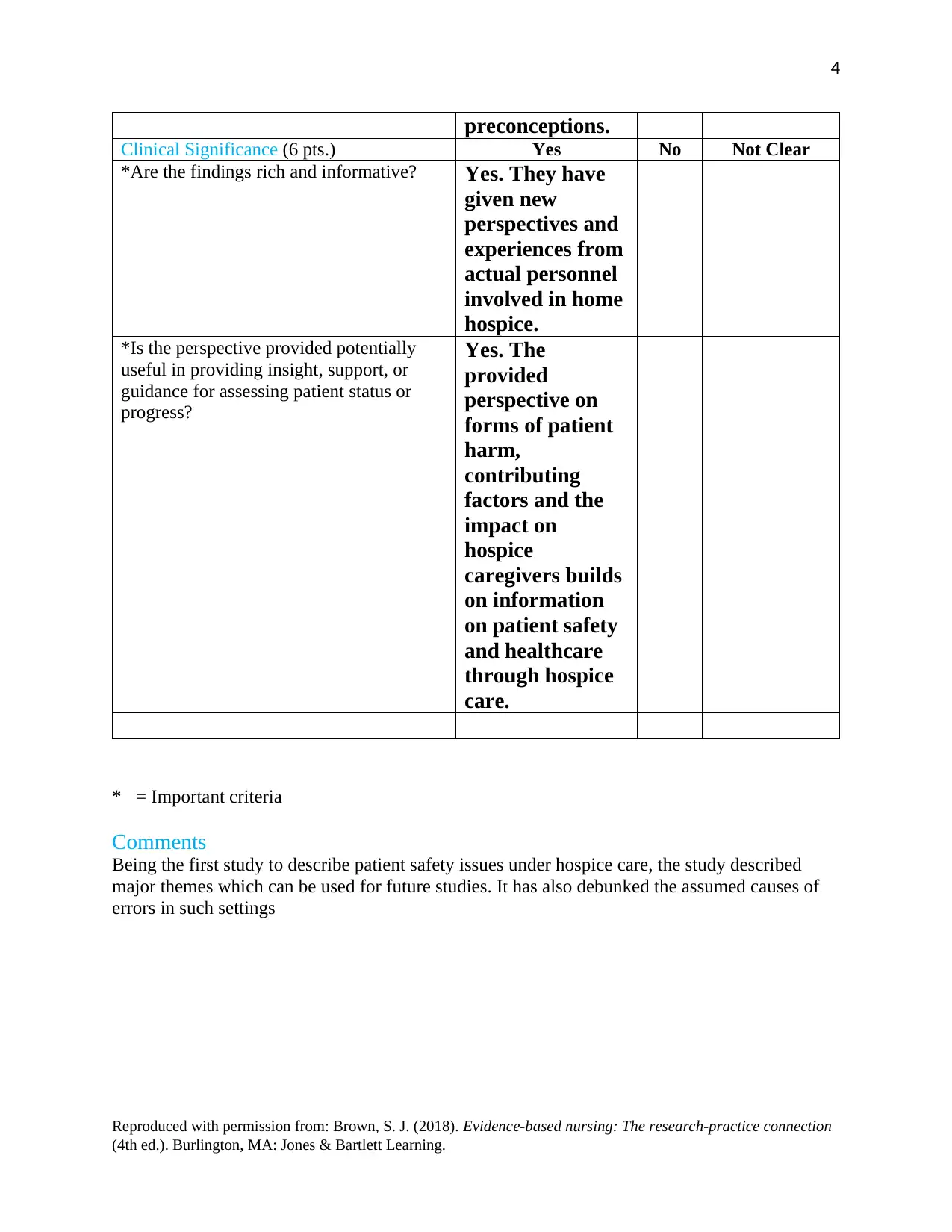
preconceptions.
Clinical Significance (6 pts.) Yes No Not Clear
*Are the findings rich and informative? Yes. They have
given new
perspectives and
experiences from
actual personnel
involved in home
hospice.
*Is the perspective provided potentially
useful in providing insight, support, or
guidance for assessing patient status or
progress?
Yes. The
provided
perspective on
forms of patient
harm,
contributing
factors and the
impact on
hospice
caregivers builds
on information
on patient safety
and healthcare
through hospice
care.
*= Important criteria
Comments
Being the first study to describe patient safety issues under hospice care, the study described
major themes which can be used for future studies. It has also debunked the assumed causes of
errors in such settings
Reproduced with permission from: Brown, S. J. (2018). Evidence-based nursing: The research-practice connection
(4th ed.). Burlington, MA: Jones & Bartlett Learning.
4
Clinical Significance (6 pts.) Yes No Not Clear
*Are the findings rich and informative? Yes. They have
given new
perspectives and
experiences from
actual personnel
involved in home
hospice.
*Is the perspective provided potentially
useful in providing insight, support, or
guidance for assessing patient status or
progress?
Yes. The
provided
perspective on
forms of patient
harm,
contributing
factors and the
impact on
hospice
caregivers builds
on information
on patient safety
and healthcare
through hospice
care.
*= Important criteria
Comments
Being the first study to describe patient safety issues under hospice care, the study described
major themes which can be used for future studies. It has also debunked the assumed causes of
errors in such settings
Reproduced with permission from: Brown, S. J. (2018). Evidence-based nursing: The research-practice connection
(4th ed.). Burlington, MA: Jones & Bartlett Learning.
4
Paraphrase This Document
Need a fresh take? Get an instant paraphrase of this document with our AI Paraphraser
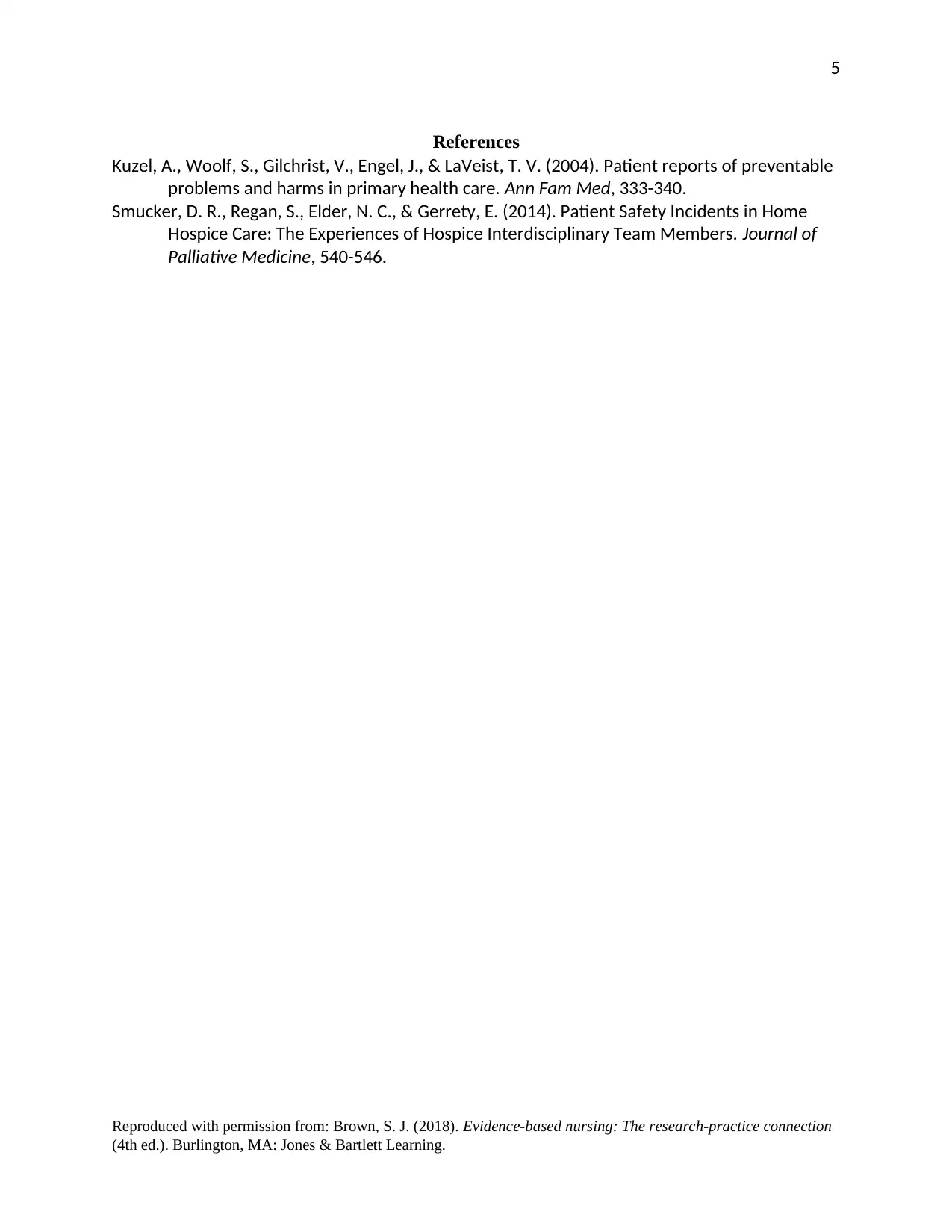
References
Kuzel, A., Woolf, S., Gilchrist, V., Engel, J., & LaVeist, T. V. (2004). Patient reports of preventable
problems and harms in primary health care. Ann Fam Med, 333-340.
Smucker, D. R., Regan, S., Elder, N. C., & Gerrety, E. (2014). Patient Safety Incidents in Home
Hospice Care: The Experiences of Hospice Interdisciplinary Team Members. Journal of
Palliative Medicine, 540-546.
Reproduced with permission from: Brown, S. J. (2018). Evidence-based nursing: The research-practice connection
(4th ed.). Burlington, MA: Jones & Bartlett Learning.
5
Kuzel, A., Woolf, S., Gilchrist, V., Engel, J., & LaVeist, T. V. (2004). Patient reports of preventable
problems and harms in primary health care. Ann Fam Med, 333-340.
Smucker, D. R., Regan, S., Elder, N. C., & Gerrety, E. (2014). Patient Safety Incidents in Home
Hospice Care: The Experiences of Hospice Interdisciplinary Team Members. Journal of
Palliative Medicine, 540-546.
Reproduced with permission from: Brown, S. J. (2018). Evidence-based nursing: The research-practice connection
(4th ed.). Burlington, MA: Jones & Bartlett Learning.
5
1 out of 5
Your All-in-One AI-Powered Toolkit for Academic Success.
+13062052269
info@desklib.com
Available 24*7 on WhatsApp / Email
![[object Object]](/_next/static/media/star-bottom.7253800d.svg)
Unlock your academic potential
Copyright © 2020–2025 A2Z Services. All Rights Reserved. Developed and managed by ZUCOL.
